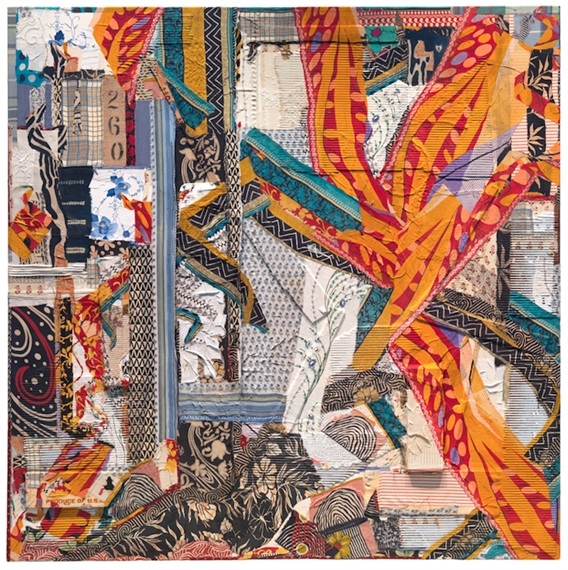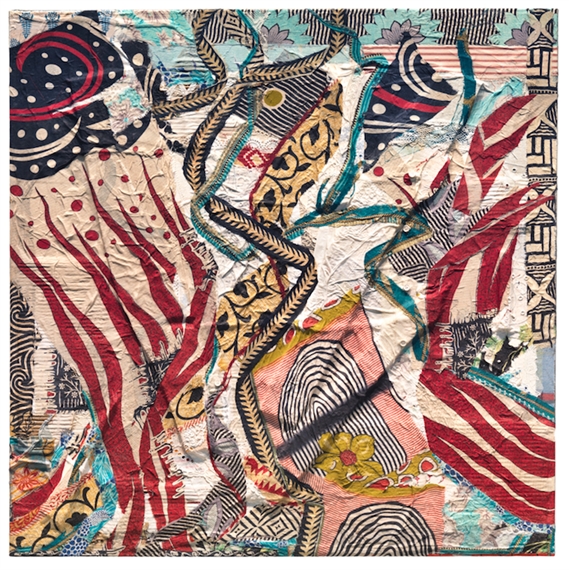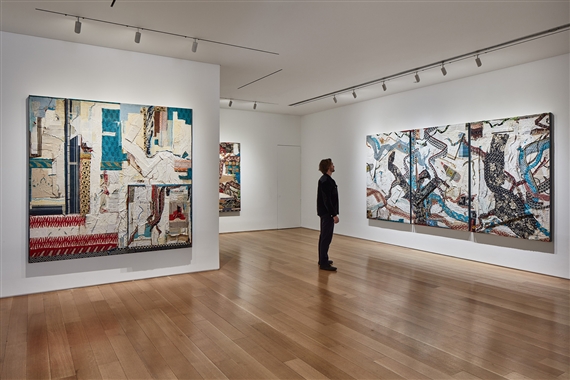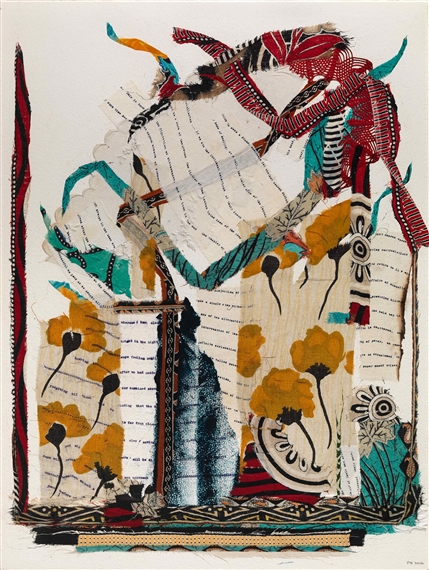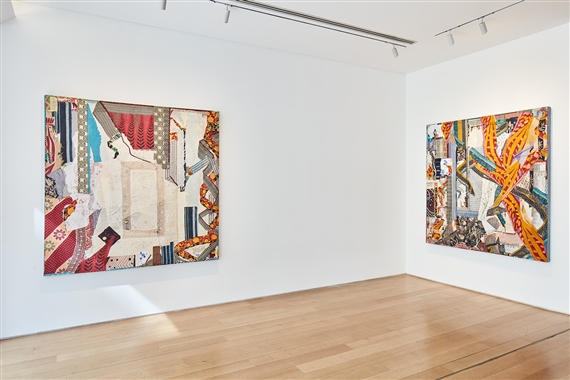Night Ferry
By Peter Sacks
Blood-drop, lung of fire setting past
the sea bell and wave; why am I separate
from that giant burrowing into further life?
The body breathes and rides
a heavy-netted ocean swollen
by the tide. Under the half-moon
it’s the lighthouse light that turns
the rest of me to early nightfall,
headland, home. I send it back,
a mirrored flickering across cold waters.
We allow ourselves the crest that breaks
above the surface then re-forms.
We make it human and we call it love.
This wintering is my own and not the world’s,
although the world is wintering.
“Like Excavating In Reverse” — The Poet Who Became a Painter
Originally published in: MutualArt MAY 11, 2018
With his new exhibition Migrations now showing at Marlborough Fine Art in London, we spoke to South African born artist Peter Sacks about his unique style of painting.
Peter Sacks is a painter, poet, and emigrant. His work fits somewhere between painting and collage — rich and deeply layered palimpsests that condense multiple histories, cultures, timelines and references into beautifully evocative works.
Having grown up in apartheid-era Durban, Sacks left his home country aged 20 to study in the US. As a young man he was an Olympic-caliber backstroker, banned from competition because of his then South African citizenship, and upon arriving in America he experienced the race riots in Detroit. Sacks remained in America, and has been a Literature professor at Harvard University since 1996, and is renowned for his work as a poet. In the last 20 years Sacks has stopped writing poetry, and taken up painting.
Sacks’ painting reflects his obsession with movement. He has trekked extensively on foot across North and South America, North Africa and India, and uses materials from Syria and a refugee camp in Greece. Much of his work deals with the recurrent themes of forced migration; displacement, conflict, and regeneration. Made up of layers of culturally and personally significant materials, as well as everyday objects and snippets of manually typed text, the paintings are vibrant, entrancing, and full of energy — enormously sad, yet tremendously uplifting.
Peter Sacks at work in his studio.
MutualArt: How would you define your work in your own terms?
Peter Sacks: Well I think of my work as some original combination of painting and collage and palimpsest. The way in which they feel more painterly is that I’m using cloth to make gestures and create movement; as if one could paint with cloth. Indeed the paintings are all applied using brushes. The idea is to get things to flow, to blend, to move in space in a way often collage doesn’t do. Some layers are paint, some are cloth, some are cardboard, some are wood. So it’s very difficult to define. I think I’m painting by other means, you might call it.
Every piece of the material that’s gone into these works has gone through some kind of transformative process. One example of course would be the typewriter. I’ll take a piece of 19th century linen, or lace or cotton, and start typing out chosen texts upon it. I’m interested in the play of the textual and the textural, since they both go back to the same root. The very word ‘text’ has to do with weaving and the process of creating a textile.
There’s a play of tensions at the level of depth; things are side by side, but they’re also pushing up from below, suggesting some kind of pressure, but also time, and temporality. The paintings are timescapes, as much as landscapes or figurescapes. These are works that are doing many things at once and so do resist being put into a category.
Peter Sacks (b. 1950) Outpost 2, 2017, 183 x 183 cm (72 x 72 in), courtesy of Marlborough Fine Art.
What do you mean by timescapes?
Well, the finished work is a collapsing or a condensing of time, but in order to achieve that, you have to have put the uncondensed time into making it… so it’s very, very labour intensive. They take a long time to make — whether it’s the typing, the gathering, or the placing, each sedimentary stratum has to be carefully put together.
Then of course the temporality is built into the fact that some of the materials themselves are very old. Some of them go back to the 19th century, others a quite new, some are post-industrial, whether its cardboard, or a jean shirt, or buttons. But that’s all in there, as well as the time and the labor of the people who originally made the lace or dyed the cotton.
I also hope that the viewer will spend a lot of time with the paintings, discovering and unpacking them. The idea is that you become drawn into the work and then spend time excavating it. I think of my process of making these works as ‘excavating in reverse’. So there’s a kind of archaeological dig going on for the maker, and then later for the viewer.
Peter Sacks (b. 1950) Quickening 4, 2017, 91 x 91 cm (36 x 36 in), courtesy of Marlborough Fine Art.
What underlies your interest in migration and displacement?
I grew up in South Africa, and left for the first time when I was 16. I migrated and spent the remainder of my life, either in the United States, England or France. So that whole experience of uprootedness and displacement has stayed with me. I often wonder: what are the circumstances in which one settles again, if ever? For so many people, this experience has been massively intensified and made anguishing by the contemporary situations in which they are forced to migrate and flee. So these paintings refer to the conditions in Syria. Some of the pieces of cloth were given to me via someone who’d been working with refugees in Lesvos.
How do you see the relationship between form and content in your work (given that you use the literal materials as paint)?
I find it almost impossible to separate form and content. The materials are the content, and the ways in which the materials have been manipulated are meaningful. It’s the same reason I’m so interested in poetry. Poetry is one of the places in which language is torqued to the extent that form and content are inseparable.
How has your background as a poet influenced your work? Is there a link between your poetry and your painting?
There is linkage. They’re separate media, although my paintings do include passages of poetry that I have typed out. Some of them are drawn from poets, such as the triptych Report From The Besieged City, which uses language from the great Polish poet Zbigniew Herbert. As a poet, I no longer write, so all of that has migrated into these works. But I want the works to retain elements of the poetic.
Would you say that your interest in migration is more personal or political?
It’s like with form and content; the personal is political. This is a phrase that goes back to the 60s.
Migrations shows at Marlborough Fine Art until 19 May.
How much are you open to the viewer projecting onto your work?
I’m very open to interpretations. These works are invitations for kinds of discovery, for a play of relatively free associations. People can bring their own experiences and imaginings. The works are very much supposed to draw on the conscious and the unconscious, so I don’t have an a priorimessage. They’re sites in which things can occur. And I hope that occurence will be different with each viewing. Someone could come up close and see something that’s been typed and therein gain a new idea.
Having said that, there may be some overall atmospheric meanings that I would hope do register in the viewer. Namely a sense of fragmentation and reintegration. I grew up in a very segregated country, so there’s an attempt to reintegrate and put together things that would have otherwise be kept apart. But I want that to somehow be felt. I want there to be a feeling that there are remnants in here that are being saved, scraps that are being given a new life.
Some of the language that I’ve chosen comes from specific sources. If you read up close, you might notice that some of the text comes from conflicts, civil wars, forced migrations or political events. These paintings have been made since Iraq, since Syria, and since my awareness of the emergence of anti-democratic forces in what had previously been democratic countries. Most of these were brought to completion since the Trump elections. There’s a sense of menace but also of resistance.
Peter Sacks (b. 1950) False Bay 2, 2015, 56 x 76 cm (22 x 30 in), courtesy of Marlborough Fine Art.
You mention that even as a maker, you don’t have a preconceived message. How do you go about producing a work without having decided its meaning?
I start with a kind of tabula rasa — a canvas. I usually put it on the floor, so it feels like some extension of the ground. Then I start placing items almost at random. Perhaps pieces of cloth, corrugated cardboard or wood, which I know won’t be visible at the end, but form the under-matrix. These have determining effects, both visual and emotional. If you’ve got a piece of a 19th Century monogram, or something you feel has been worn, lived in and made carefully, it’s going to have an effect on what you put on top of it, and it’s going to impress up from beneath. Perhaps you might leave a bit exposed. But that’s a very intuitive process.
Then I might think, ‘I should burn that edge’. And then I’ll just burn it. Which can be risky and get out of control; I’ve had some bad accidents. But I like the idea of chance or the ordeal. There’s a ritualistic element to it which gives a kind of autonomy or agency to the materials. They begin to dance together or make a sort of music together. They interfere with each other. One becomes the prehistory of another which gets laid over it. There’s an improvisational quality to the process, whereby each material responds to the other, and I’m very much working from my unconscious. Making these paintings can take months, or even years.
Migrations shows at Marlborough Fine Art until 19 May
Your paintings contain a lot of art historical references, and intellectual or academic ideas, how do you ensure that the final product works on an emotional level?
That’s a terrific question. Let’s think of compost. Scraps of what one eats, and choses to store and put together. Remnants of that retain a potential, or generative power. Things that you’ve read, things that you’ve learned, thing that you’ve allowed to seep into the lower parts of your psyche, such that they become second nature. All of that lives together, composts itself, gets digested and then finds its way up. My works aren’t about learning but about experiencing; allowing what your mind has become to be a kind of organ that expresses itself in some way. You know, I think of the optical unconscious. Things you’ve half seen, or seen and forgotten, that somehow come up to the surface. There’s a poetry involved.
How does your travelling fit into your process?
Most of my travelling was done when I was younger. I would take long, often solitary treks. I went off with a hammock for four months and walked across South America, going up into the Andes, going down into the Amazon. Those journeys I think have fed me more than any recent travelling I’ve done. They’ve become a template for my works — I want each painting to suggest a kind of movement or journey, rather than a place. There’s a sense of chance and collision, but also of something sequential, as you make your way across the surface of the work. Often I like to think of myself as being reduced to the size of an ant, and then allow the ant to move all over the painting, encountering the ridges, the blockages, the discontinuities, the ruptures — getting lost but then picking up another piece of the track. Travelling has been very formative for me.
Peter Sacks (b. 1950) Report From The Besieged City I, 2014-16, triptych, 196 x 394 cm (75 ¾ x 155 in), courtesy of Marlborough Fine Art.
Who are your major artistic influences?
One of the strongest art historical influences on my work is cave paintings. So that takes us back 35-40,000 years. I grew up as a child in South Africa where there was still many cave paintings, which were made by people who had somehow survived from very early times. Unlike in France or Spain, where the cave paintings are made by people who have since disappeared, there are still traces of these people, for instance the people who have been somewhat exterminated or otherwise driven out, who made these paintings. Cave paintings feel as though they’re integrated not just into history, but into the materials of the cave wall, the stone, the soil and so on. Medieval frescoes have also had a huge affect on me, partly because you can think of many of them as a kind of cave painting. Many of them are decayed, so seem to exist again in deep time. In the contemporary period there are people like El Anatsui, Doris Salcedo, William Kentridge, Anselm Kiefer — artists doing very different things to what I do, but whom I respect very much.
What are you most excited about with this exhibition?
What’s exciting me about this exhibition is its vibrancy and the variety in terms of color. It’s more graphically kinetic, and I think it has a different level of vitality and complexity. For me it’s been a challenge about making abstract art that nevertheless pulls, that has some bearing on our material world. In that sense I want to put the traction back into abstraction. Because migration is a kind of abstraction — somebody’s being abstracted from their original matrix. So those are the emotional fields I want to achieve, whilst also making a visual object that is delightful, that gives pleasure. That’s one of the great challenges — to find a balance between a deep sense of the tragic, that still manages to acknowledge the joys of life.


